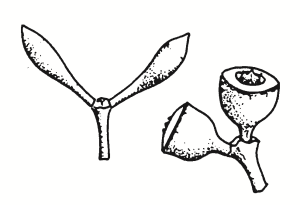Family:
Myrtaceae
Eucalyptus robertsonii
Robertson’s Peppermint
Other Names:

Regional Subspecies:
Eucalyptus robertsonii subsp. robertsonii
Similar Species:
Similar to Narrow-leaf Peppermint (E. radiata), although the Herbarium at Sydney has no records of this species in the region. Robertson’s Peppermint is commonly known as Narrow- leaf Peppermint throughout the region.
Occurrence:
Regional:
Widespread in the higher rainfall areas generally east of the Hume Highway.
Australia:
NSW, Vic.
Habitat:
Grassy or dry sclerophyll woodland or forest on lighter soils, often granite.
Habit:
Tree to 30 m high. Bark grey to grey-brown, shortly fibrous, smooth above, shedding in long ribbons. Dense crown of fine blue-grey foliage.
Site Preference:
Moist deep soils. Tolerates moderate frost, some snow and poorly drained soil.
Characteristics:
Fast growing. The leaves are rich in oil, giving off a strong aroma when crushed and following rain.
Flowering:
Feb-Mar.
Seed Collection:
From seed. Germinates readily.
Propagation:
From seed, particularly in the absence of competitive exotic grasses or weeds, and during wet summers. Coppices well.
VALUES:
Shade & Shelter:
Useful medium to high-level cover in windbreaks.
Land Protection:
Useful, although burns quickly.
Wildlife:
Good habitat. Flowers provide pollen for various insects, mammals and birds. Insect-eating birds are attracted, such as treecreepers gleaning the bark and pardalotes feeding in the leaves. Foliage is occasional forage for koalas. Various native birds feed on the flowers, seed and fruit. Old trees develop hollows which are nesting sites for birds and mammals.
Timber:
Heartwood light brown, sometimes with pinkish tinge. Generally straight-grained. Density about 720 kg/m3. Used for general construction or in joinery (better quality logs). High shrinkage rate.
Ornamental:
Attractive specimen for larger gardens and parks. Attractive foliage.
Other:
High essential oil content in foliage of some provenances.
